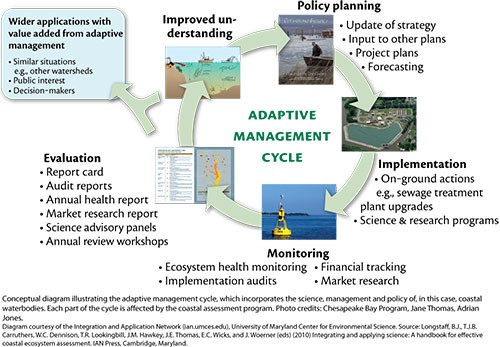Innovations in Environmental Synthesis, Reporting and Governance: Part 12 - Questions From the Seminar
Bill Dennison ·QUESTION: Hi, Adam from the Department of Environment. Thanks for the presentation. One of the key messages I got which was really cool was that you think that it’s important to synthesize as you go through the research. I want to know the challenges in terms of synthesizing and sharing knowledge and data before publishing. What are the pros and cons? How do you balance that juxtaposition?
BILL: Very good question. What we have to maintain is opportunities for researchers to get peer review publications because that counts. That’s part of their ten year promotion package, and so we don’t want to short change that. Yet, we can’t necessarily wait five years for the full process of analyzing data, submitting the journal, and eventually seeing that trickle out. And what we’ve done is try to do both. In Southeast Queensland we wrote a couple books along the way, capturing the science as the rolling synthesis, as I call it. So, most of this now is truly into scientific literature, but we actually did this from start to finish in six months, and we did it in a storyboard fashion. The way we do it is we mock them up as a story board so we try to say to ourselves “What’s the message?” And we use an active, declarative statement. Then how are we going to support that statement that the scientist wanted to make? Well, we’ll use some photographs, we'll use a map with some little data insets, and we’ll use a diagram. And then we have room for 150 words. So give us 150 words, give us these maps and charts and we’ll use that two page spread. So, you can mock this up and generate these story boards. In fact, the way we did the second book is we literally wallpapered the wall. Each page was mocked up. Then it can be turned around relatively quickly, and it doesn’t preclude publications. In a couple of cases, we will have a whole PhD thesis in one page. It was relevant to the topic, but wasn’t worth more than one page, because we only have so much room. This one book is eighty authors, so everybody gets a piece of it, everybody gets credit. I think multi-author, synthetic publications are a way to augment the science. And we can’t wait. I think the epiphany came to me when we were doing this healthy waterways project, and an engineer came up to me and said “Bill I would like to know whether we should put this pipe a kilometer off shore, or twenty kilometers. What do you thinks best?” (Bill): Good question. We’re going to do the modeling, research and well turn it around within a year which is really fast for scientific things and well get you an answer. He told me “You don’t understand, were going to make a decision tomorrow. With or without you, we’re making a decision, so; what do you think?” So the epiphany for me was that you cannot do the science, package it together, and then implement it. You have to do the management and science in parallel, feeding across all the way, and moving forward. It’s not linear; it needs to be in parallel.

QUESTION: Mike from CSIRO. After that answer I thought I had to ask you to solve one of the great dilemmas we have in contested science. One of the reasons why there is a concern with going and getting into the field of new literature, is because we now, in areas like climate change, and a whole range of related areas, the issue has become a matter of opinion. All opinion is equal. Depending on which newspaper you’re getting, some are more equal than others, and the only way we discriminate, what we as scientists say, is because of new literature, so there has become a real danger in speaking to that.
BILL: Good Point, and good example, with climate change. What I will argue is that the books that we are producing with Healthy Waterways have more intense peer review than the average anonymous 2 reviewers that you have for a scientific journal. I’m married to an editor, so I have to listen to her talk at night about the vagaries of getting reviewers. But those books are pretty intensely reviewed. It’s kind of like IPCC. And I know those reports are not “peer reviewed”, but eight hundred scientists went into drafting it, and fifteen hundred reviewed it, and of course they come up with the climate denier to counter the hundreds of scientists that went into the IPCC. So that’s an issue that we’re all going to have to deal with. But, my thinking is that we always want to provide the transparency and accountability, which is one of the tenants of STATing. Let’s show what’s undeniable. Use the photography, use maps, use diagrams to show what can’t be argued, and then we can talk about the fixes, rather than whether it’s a real issue or not. So it’s definitely a dilemma and something we need to think about.
This blog post was created from a presentation by Bill Dennison to the Terrestrial Ecosystem Research Network in Melbourne, Australia on 29 Mar, 2011 (full powerpoint presentation can be accessed on IAN Press.
About the author
Bill Dennison

Dr. Bill Dennison is a Professor of Marine Science and Vice President for Science Application at the University of Maryland Center for Environmental Science.

